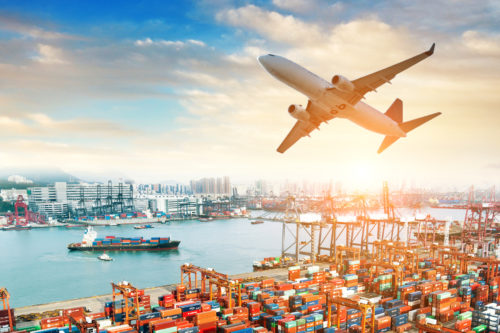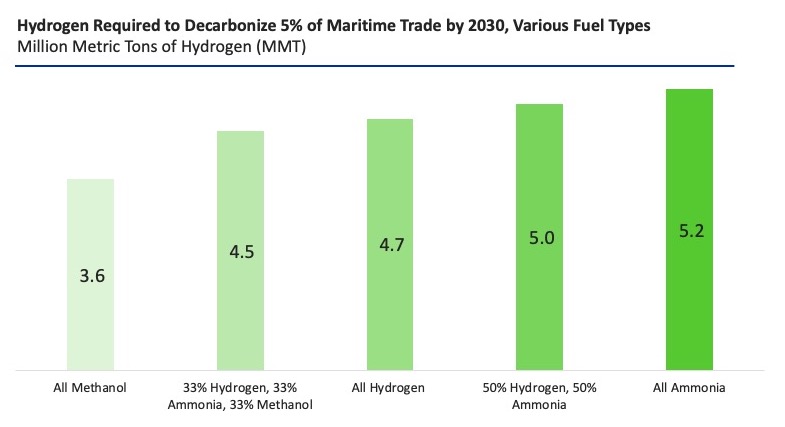Plane flying over the harbor.

Shipping and Aviation Plan to Go Net Zero. How?
This week has seen a seismic shift, with the global maritime shipping and aviation industries both committing to move to net zero by 2050. For the shipping industry, this is further progress on the landmark Poseidon Principles. For aviation, this shows a new level of ambition.
But both sectors are difficult to decarbonize, and a central question remains: How will they do it?
We don’t yet have all the details of the technologies that will be used—but neither do these industries. The International Chamber of Shipping (ICS) has stated that in order to reach net zero, 5 percent of the global shipping fleet will need to be zero-emissions by 2030. This means constructing and deploying thousands of vessels based on new technology that has not yet been deployed at scale, as well as building fuel supply chains to support them.
The airline industry has proposed solutions that require less disruption to the industry’s operating models—although here, too, new technologies and new types of planes are likely to play an increasing role. In both cases, more funding to research and scale solutions will be critical.
In this blog, we are going to look at some of the more likely potential technologies that both maritime shipping and aviation could deploy to decarbonize their fleets and operations.
Electrification for Short-Haul
For both ships and planes, there is a solution for short-distance trips that is already familiar from ground transportation: electrification. Since December 2019, North America’s largest seaplane airline has been taking test flights of battery-powered electric aircraft. Harbour Air, which operates in the Vancouver, B.C., region, is currently pursuing regulatory approval to take passengers in electric planes by 2023 and plans to convert its entire fleet of 42 planes to battery power.
And this summer, Norwegian company Yara International announced that it will transport cargo for the first time in its new, autonomous battery-powered container ship. Both of these developments show the promise of electrification for short-distance trips, including the airplane trips that serve as lifelines for remote communities in places like the Australian Outback, parts of Canada, and other areas not easily accessible by road.
“Short-haul for both shipping and aviation can likely be electrified,” notes Thomas Koch Blank, a senior principal in RMI’s Climate-Aligned Industries program. However, he understatedly describes the electrification of longer international and intercontinental routes for both industries as “challenging.”
For aviation, the challenge is the weight of batteries. For shipping, it is their bulk. “The volume of batteries needed is crazy,” notes Koch Blank. In both cases, the battery solutions that are revolutionizing ground transport simply don’t have the energy density to take on mid-or long-distance routes. And these longer routes are where most of the fuel is consumed.
Sustainable Aviation Fuel
For aviation, the only low-carbon solution that is currently being deployed commercially is sustainable aviation fuel (SAF). While SAF can be made from a variety of sources including crop residues, waste vegetable oils, and CO2 itself, global market leader SkyNRG currently distributes biofuels made from waste oils.
The Mission Possible Partnership—a coalition of organizations including RMI working to decarbonize heavy industry—describes SAF as the only viable short-term option for reducing carbon emissions from aviation. This is because it can serve as a drop-in replacement for the jet fuel used in commercial planes and is also compatible with airport fueling infrastructure. Furthermore, SAF poses no range limitations.
But in order for SAF to play a major role, it will need to be dramatically scaled, which will require substantial investment. Currently the global supply of SAF comes from one facility in Southern California operated by World Energy, which can produce less than 0.01 percent of the industry’s annual fuel demands.
But while SAF may play a major near-term role, there are limitations on the potential supply of waste oil and other biological sources of SAF for the aviation industry. A next-generation approach known as power-to-liquids (PtL) is currently less mature but carries even greater carbon-reducing potential. PtL uses electricity and CO2 to synthesize liquid hydrocarbon fuels, which can be truly zero-carbon if the electricity is provided by renewables.
Hydrogen-Powered Skies
In the longer term, MPP is exploring a range of options for aviation. The organization says that hydrogen-powered aircraft will be critical for reducing emissions from mid- and long-term flights. These planes include both fuel cell and hydrogen combustion aircraft.
Several promising startups are already operating in this area, including ZeroAvia, which held a test flight for a passenger aircraft in summer 2020. Additionally, European plane maker Airbus has unveiled a series of hydrogen-powered concept planes.
And while aircraft that emit only water still seem a distant promise, MPP says that fuel cell airliners could take a share of mid-range flights by 2030, and that hydrogen combustion could power even long-distance flights by 2035.
Hydrogen on the Open Sea
For shipping, hydrogen may play an even larger role. RMI’s Koch Blank notes that much of the available biofuel resources will need to be directed to airlines. “If you aren’t doing biofuels, your zero-carbon options are hydrogen, ammonia, or e-methanol,” explains Koch Blank. But ultimately these other sources may also require hydrogen. A main method for producing ammonia requires hydrogen as a feedstock and e-methanol is derived from hydrogen and CO2.
Both hydrogen and ammonia are already being tested as fuels, and French shipping company CFT is planning to give a hydrogen-powered container ship a test run on the Seine later this year. Additionally, shipping giant Maersk has placed orders for eight ships that can run on methanol, with the first scheduled to be deployed in 2024.
But for hydrogen-powered shipping to be emissions-free, the fuel needs to be produced in a way that does not emit greenhouse gases—namely, electrolysis using renewable energy to produce “green” hydrogen. In order for green hydrogen to power global shipping, we’re going to need a lot more electrolyzers than we currently have—and fast.
Tessa Weiss, an associate in RMI’s Climate-Aligned Industries Program, estimates it will take between 3.6 million and 5.2 million metric tons of hydrogen each year starting in 2030, depending on the mix of fuel used, to meet ICS’s target of decarbonizing 5 percent of maritime trade. Making that much green hydrogen will require 41–60 gigawatts of electrolyzers running at a 50 percent capacity factor.
That’s around 14–20 times the 0.3 gigawatts of electrolyzers that are currently operational, and more than the 40 GW of electrolyzer projects that BloombergNEF is tracking. However, it is only a small portion of the 850 GW that will be needed by 2030 for green hydrogen to play its role in a net-zero world. Beyond aviation and shipping, large volumes of hydrogen will also be needed for a number of applications, including steel production.
One bright spot for shipping is that as the world decarbonizes, one of the main cargoes of long-haul routes will disappear: petroleum and other fossil fuels. Koch Blank estimates that fossil fuels constitute 40 percent of what is now transported over the ocean, and so decarbonization could cut back on the demand for energy carriers, as well as the energy requirements of those ships.
Vision and Will
There are multiple potential pathways to decarbonize both aviation and shipping, but it is not necessary or even possible to know all the details of how this will play out. What is important now is the will to carry out the vision that the aviation and maritime shipping industries are showing.
In both cases, this transformation will need investment in research, development, and early-stage deployment of zero-carbon solutions. This includes not only building zero-carbon vessels, but also the fuel production and supply chains that will feed them.
The nuts and bolts of bringing these industries onto a sustainable path will be further explored in a panel discussion on Thursday, October 14. This conversation will feature executives and board members from United Airlines, Trafigura, Bank of America, and ArcelorMittal, and will be moderated by Faustine Delasalle of the Energy Transitions Commission, who also serves as the co-executive director of MPP.
We have the vision to bring aviation, shipping, and other heavy industries to a sustainable pathway. Now comes the hard work of doing it.

